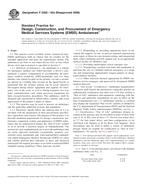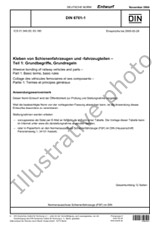We need your consent to use the individual data so that you can see information about your interests, among other things. Click "OK" to give your consent.
ASTM F2020-02a(2009)
Standard Practice for Design, Construction, and Procurement of Emergency Medical Services Systems (EMSS) Ambulances (Withdrawn 2018) (Includes all amendments And changes 7/16/2018).
Automatically translated name:
Standard Practice for Design, Construction, and Procurement of Emergency Medical Services Systems (EMSS) Ambulances
STANDARD published on 1.3.2009
The information about the standard:
Designation standards: ASTM F2020-02a(2009)
Note: WITHDRAWN
Publication date standards: 1.3.2009
SKU: NS-52470
The number of pages: 45
Approximate weight : 135 g (0.30 lbs)
Country: American technical standard
Category: Technical standards ASTM
The category - similar standards:
Annotation of standard text ASTM F2020-02a(2009) :
Keywords:
ambulance, emergency medical ground transportation, EMS vehicle, Advanced life support (ALS), Alternative emergency warning light system, Ambulance, Construction, Design, Emergency medical services (EMS), Emergency medical services systems (EMSS), General vehicular design, Hardware construction/installation, Pediatric facilities/applications, Procurement, ICS Number Code 43.160 (Special purpose vehicles)
Additional information
| 1. Scope | |||||||||||||||||||||||||||||||||||||||||||||||||
|
1.1 This practice covers certified, tested, commercial type, EMSS ambulances built on chassis that are suitable for the intended application and meet the requirements herein. The ambulances are front or rear wheel driven (4x2) or four wheel driven (4x4) and warranted as specified in Section 9. 1.1.1 Definition of Ambulance—An ambulance is a vehicle for emergency medical care which provides: a driver's compartment; a patient compartment to accommodate an emergency medical technician (EMT)/paramedic and two litter patients (one patient located on the primary cot and a secondary patient on a folding litter located on the squad bench) so positioned that the primary patient can be given intensive life-support during transit; equipment and supplies for emergency care at the scene as well as during transport; two-way radio communication; and, when necessary, equipment for light rescue/extrication procedures. The ambulance shall be designed and constructed to afford safety, comfort, and avoid aggravation of the patient's injury or illness. 1.1.2 This practice may be used to procure an ambulance and the applicable additional systems and equipment. 1.1.3 Purchasers should follow the ordering data in 9.2 to aid them with the preparation of their procurement specification, requisition, and contract. The purpose of this practice is to describe minimum requirements for design, construction, performance, equipment, testing, and appearance of EMSS ambulances that are authorized to display the “Star of Life” symbol so as to provide a practical degree of standardization. The reasons for such standardization are to provide ambulances that are easily detected, nationally recognizable, properly constructed, easily maintained, and, when appropriately equipped, will enable Emergency Medical Technicians (EMTs) to safely and reliably perform their functions as basic and advanced prehospital life support providers as set forth in national EMSS standard training guidelines. These functions include: 1.1.3.1 Responding to, providing appropriate basic or advanced life support, on-site, to persons reported experiencing acute injury or illness in a pre-hospital setting, and transporting them, while continuing such life support care, to an appropriate medical facility for definitive care. 1.1.3.2 Providing interhospital critical transport care. 1.1.3.3 Transporting essential personnel and equipment to and from the site of a multiple medical emergency or a triage site and transporting appropriately triaged patients to designated medical facilities. 1.1.3.4 Other functions deemed appropriate by EMSS ambulance service managers and approved by designated EMSS medical directors. 1.2 “Star of Life” Certification—Ambulance manufacturer/contractor shall furnish the purchaser(s) citing this practice an authenticated certification and label (see 6.19) that certifies a “Star of Life” ambulance and equipment complying with this practice and applicable amendments (if any) in effect on the date of manufacture (see 7.3). Ambulance vehicles so certified may display the registered “Star of Life” symbol, as defined by the U.S. Department of Transportation (DOT) and the National Highway Traffic Safety Administration (NHTSA), see Fig. 1. 1.3 Classification—“Star of Life” ambulance designs included in this practice may be described in terms of their body type (I, II, or III), class of drive (“1” for two rear wheel drive or “2” for four wheel drive), and floor configuration (A for Advanced Life Support or B for Basic Life Support). Such descriptions may be used to define a variety of ambulance designs which are eligible for certification as “Star of Life” ambulances. (To specify, see 9.2.2 and 9.2.3). Note 1—For optional advanced life support (ALS) applications, users should consider specifying a modular (Type I or III) ambulance. Modular ambulances provide additional space and compartmentation for cardiac monitors, drug cases, and so forth. The basic life support (BLS) configuration is standard on all types. 1.3.1 Type I—Conventional truck, cab-chassis with modular ambulance body (see Fig. 2).
1.3.1.1 Type I—AD (Additional Duty—with increased GVWR, storage, and payload capacity)—A or B or Neonatal, Critical Patient Transport, or A or B with Rescue and Fire Suppression Package (see 6.1.2.1).
1.3.2 Type II—Standard van, integral cab-body
ambulance (see 6.1.3 and Fig. 3).
1.3.3 Type III—Cutaway van, cab-chassis with integral or containerized modular body ambulance (see 6.1.4 and Fig. 4).
1.3.3.1 Type III—AD (Additional Duty—with increased GVWR, storage, and payload capacity) A or B or neonatal, critical patient transport, or A or B with rescue, or fire suppression package, or both (see 6.1.4.1).
1.4 Order of Precedence—In the event of a conflict between the text of this practice and the references cited herein, the text of this practice shall take precedence, except where required by law including Federal, State, and local laws and regulations. 1.5 The values stated in SI units are to be regarded as the standard. The values given in parentheses are for information only. 1.6 This standard does not purport to address all of the safety concerns, if any, associated with its use. It is the responsibility of the user of this standard to establish appropriate safety and health practices and determine the applicability of regulatory limitations prior to use.
|
|||||||||||||||||||||||||||||||||||||||||||||||||
| 2. Referenced Documents | |||||||||||||||||||||||||||||||||||||||||||||||||
|
Similar standards:
1.5.2008
1.10.2011
1.7.2013
1.12.2008
WITHDRAWN
1.12.2008
1.1.2010
We recommend:
Technical standards updating
Do you want to make sure you use only the valid technical standards?
We can offer you a solution which will provide you a monthly overview concerning the updating of standards which you use.
Would you like to know more? Look at this page.



 DIN EN 15431:2008-05..
DIN EN 15431:2008-05..
 Cookies
Cookies
